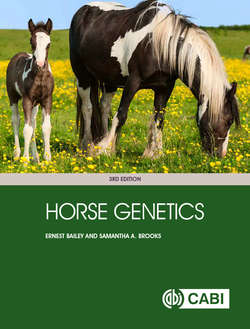Читать книгу Horse Genetics - Ernest Bailey - Страница 70
На сайте Литреса книга снята с продажи.
Schematic representation of pedigrees
ОглавлениеWhen we want to know if a trait is recessive or dominant, we can use family data in pedigrees. When using a pedigree to determine mode of inheritance we look for the following clues:
1. Dominant traits: affected offspring always have an affected parent.
2. Recessive traits: a) unaffected parents can have affected offspring (in this case we know the parents are heterozygous carriers of the gene for that trait); b) matings of affected parents always produce affected offspring.
These principles are illustrated in Figs 5.1 and 5.2.
Fig. 5.1. Pedigree representation illustrating the inheritance of a dominant trait. Squares represent males and circles represent females. The black shapes represent those individuals exhibiting the dominant trait. The open or clear shapes represent those without the trait.
Fig. 5.2. Pedigree representation illustrating the inheritance of a recessive trait. Squares represent males and circles represent females. The black shapes represent those individuals exhibiting the recessive trait. The open or clear shapes represent those without the trait.
In these cartoon representations of a pedigree, squares represent males and circles represent females. A horizontal line joining a circle and a square represents a mating of those two individuals. The circles and squares that are attached to the vertical line joining two symbols represent offspring of that mating.
The inheritance of a dominant gene is shown in Fig. 5.1. The shapes filled in with black represent those individuals inheriting the dominant gene. There are three key points to notice: (i) all individuals exhibiting the dominant phenotype (filled-in black shape) have at least one parent with that phenotype; (ii) matings of two horses with the dominant phenotype can produce offspring without the trait; and (iii) offspring which do not inherit the trait from the parents do not exhibit the trait and cannot pass it on to their offspring. Examples of dominant genes in horses include gray coat color, tobiano coat color spotting, and the disease gene for HYPP.
The inheritance pattern for a recessive gene is shown using a very similar family in Fig. 5.2. The shapes filled in with black represent those horses exhibiting the recessive trait. Again, there are three key points about recessive genes that are illustrated in this figure: (i) unaffected parents can have affected offspring; (ii) affected parents will only have affected offspring; and (iii) matings of affected horses (or carriers) to horses without the recessive gene will never produce affected offspring (illustrated here by assuming that the female mated in the third generation does not have the recessive gene and all offspring are without the recessive trait). Examples of recessive genes in horses include the red gene (e) for chestnut coat color and the gene for severe combined immunodeficiency disease (SCID) in Arabian horses. (Question: Which of the horses in the pedigree are clearly unaffected carriers? Hint: there are 9.)
